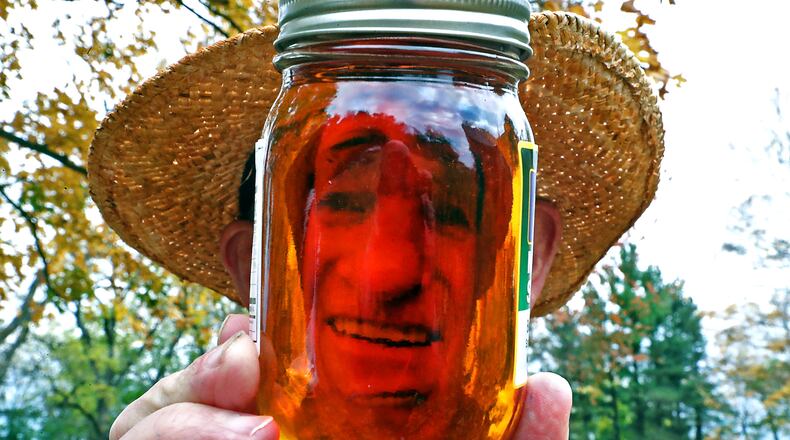About a month ago, South Charleston’s Ben Hamilton saw it coming – not as a prophet but as a prognosticator.
“We had two hard frosts in September, which is early,” said the man many know through the flourishing maple syrup business he started decades ago and moved with him to his native Clark County when he retired from his work at the Shawnee State Forest a dozen years back.
“Frost doesn’t cause the leaves to change,” Hamilton explained, “but it enhances the process, and I think that sped it up this year.”
The result, he said, is that near his Pitchin home, sugar maples leaves have been glowing so that “it looks like the sun is shining everywhere.”
A Springfield Catholic Central graduate, Hamilton got his first lessons in maple sugar making in a forestry class at Ohio State University.
“It’s considered a forest product,” he said. “Firewood, logs maple syrup, they all come from the forest.”
In 1979 he was a forester technician with the Ohio Department of Natural Resources in the Shawnee State Forest when “I started cooking with a kettle over a fire with some buddies of mine,” he said.
That required tapping enough trees near the Ohio River just west of Portsmouth to produce the 40 gallons of sap that go into each gallon of maple syrup. That, in turn, required both identifying the trees and getting permission from land owners to tap them.
Since sugar maples show themselves so plainly in the fall, it has been the season Hamilton has chosen to go prospecting for trees.
“I always know where the sugar maples are,” he said, “and (for collecting purposes) I’m always looking for a cluster.”
Although Hamilton never tired of the golden leaves and amber syrup, when his 31-year career with the ODNR ended, he thought about retiring from his hobby as well.
He sold a sap cooker about the size of a dining room table with which he had made 75 gallons of maple syrup a year.
But, an indicator of his hesitance, he brought along “some buckets and bags and the tapping tools and all that.”
He remained undecided until a Pitchin neighbor and beekeeper, Mitch Workman, not only demanded to know why Hamilton wasn’t making syrup, but upped the ante by promising to find him plenty of trees and farmers willing to have them tapped.
Soon, Hamilton ponied up for the 12-foot “dream evaporator” he’d never been able to justify buying. Then, in successive seasons, he expanded from 100 to 200 trees on the way to the 500-600 taps he works in a five-mile radius around Pitchin, South Charleston and Selma.
He’s collected other things along the way.
He said his new, close friendship with Workman is nothing he expected to experience in his later years (he’s now 68).
And he’s found some other fine people.
“I’ve got some good helpers over the years. There are three or four really reliable people who will do the gathering for me when it needs to be done and help with the cooking.”
Then there are the bonds that seem natural to the business.
“The people who get involved in it say they are like me: Their fascination with it never seems to wane.”
It renews each fall, he says, when the leaves fall and process begins again.
Immediately, he said, roots begin to collect the water, moisture and minerals and produce the sap that will jump-start the tree in spring.
“It’s almost like storing fat in the winter, if you’re a bear.”
Then on warm winter days – “when the tree’s a little confused about whether it’s winter or summer,” he said – natural processes take over.
When wood and sap warm, a natural pressure builds up in the tree, forcing the sap up.
“If you drill a hole and put a pressure gauge in there, it’ll measure the internal pressure in that tree,” Hamilton said.
And when the sap is pushed up high enough, it runs out of the taps into the collecting buckets and Hamilton fills up his dream evaporator.
And much as those of us today enjoy maple syrup, Hamilton also has a sense of the utter luxury it must have been to pioneers living on a landscape where such sweet things must have seemed heaven-sent.
But Hamilton sees the same sweetness of life at work in plain field corn and everything else that grows and sustains life on earth.
“Let’s face it. All you need is that little seed in the soil with some water and some warmth and some sun.”
About the Author
